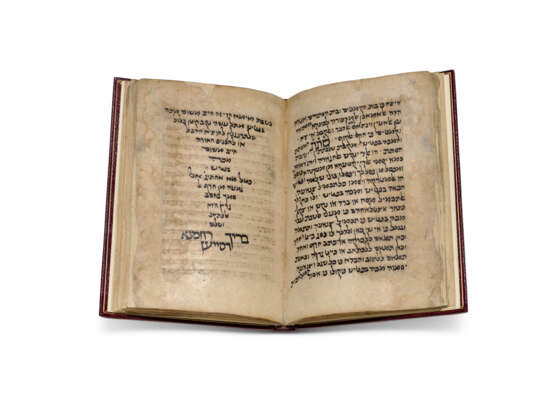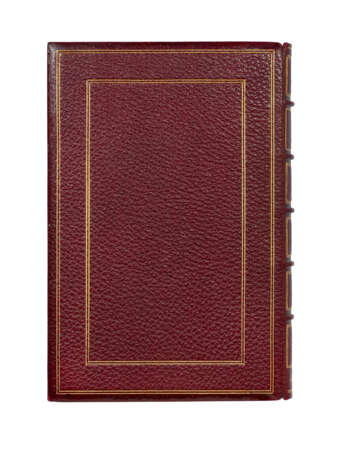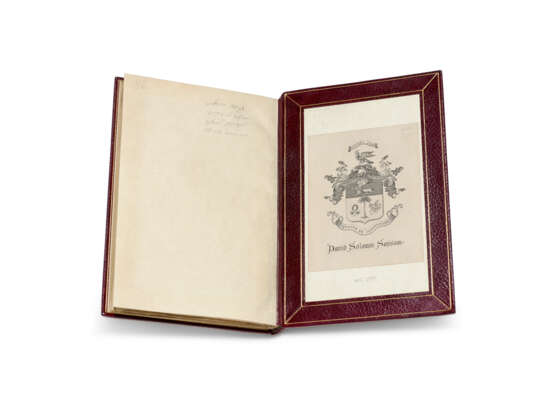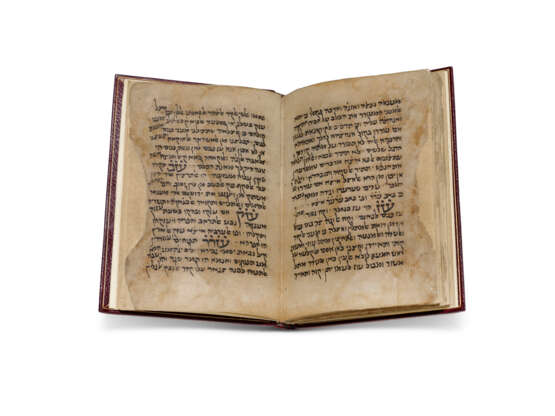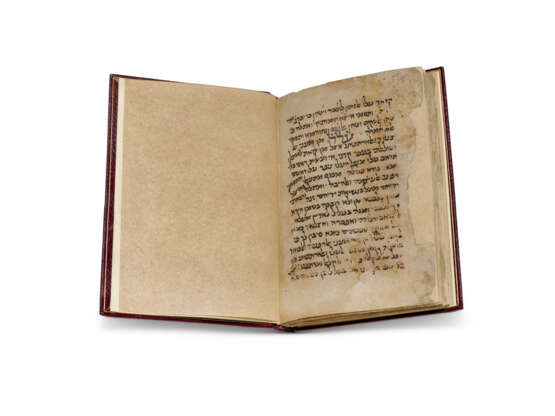ID 1214841
Lot 15 | The Sassoon 'Sufficient Guide'
Estimate value
£ 10 000 – 15 000
Tanhum ben Joseph ha-Yerushalmi (c.1220-1291), Al-Murshid al-kāfī or 'The Sufficient Guide', an alphabetical concordance to the Mishneh Torah of Maimonides, in Hebrew and Judaeo-Arabic, manuscript on paper [Egypt or Near East, 13th century]
A Judaeo-Arabic lexicon almost certainly written within the lifetime of its author, Tanhum ben Joseph of Jerusalem.
200 x 130mm. 38 leaves, gatherings originally of 8 leaves, 18 lines written in black ink in an oriental rabbinic cursive, written space: 143 x 90mm, headings in square script (lacking leaves at each end and after f.30, some staining, pages frayed at edges without loss of text, now professionally remargined and flattened). Early 20th-century full dark red morocco gilt.
Provenance:
(1) Probably from the Cairo Genizah, one of the most significant sources for any fragment of early Hebrew manuscripts. Described in a letter to the Times in 1897 by the scholar Solomon Schechter as 'a battlefield of books, [in which] [...] the literary production of many centuries had their share in the battle, and their "disjecta membra" are now strewn over its area', the Genizah was a sacred storehouse located in the Ben Ezra Synagogue in Fustat, containing some 300,000 manuscript fragments that outlined a 1,000-year continuum of Jewish Middle-Eastern and North African history. Renovations to the building in 1891 released a number of leaves onto the antiquities market, whereupon the linguist Archibald Sayce attempted, in 1892, to acquire the entire collection for the Bodleian for the asking price of '£50 and 5 bakshish' (usually translated as 'tip'). Negotiations remained fruitless, and he left Cairo blaming the inebriation of the officials for his failure. In 1896, the Scottish twin sisters Agnes S. Lewis and Margaret D. Gibson returned from Egypt with fragments from the Genizah they considered to be of interest, and showed them to Schechter, 'their irrepressibly curious rabbinical friend' at Cambridge. Schechter departed for Egypt and obtained the remaining 193,000 fragments for Cambridge University (now the Taylor-Schechter Cairo Genizah Collection, the world's largest and most important single collection of medieval Jewish manuscripts).
(2) David Solomon Sassoon (1880-1942), acquired by him in c.1921: his MS 410, with his armorial bookplate. The manuscript likely has parallel provenance with the 13th-century fragment of the same author's commentary on Leviticus, also from the Genizah, which Sassoon acquired in July 1921. Sold at:
(3) Sotheby’s, A Further Ninety-Seven Highly Important Manuscripts from the Collection formed by The Late David Solomon Sassoon, New York, 4 December 1984, lot 86.
(4) Sotheby's, 18 June 1996, lot 42.
(5) The Schøyen Collection, MS 2195.
Content:
Tanhum ben Joseph of Jerusalem, also known as Tanḥum ha-Yerushalmi (1220–1291), was a 13th-century Hebrew philologist and biblical exegete who compiled several Hebrew works, the most notable of which was a lexicon on Mishnaic words entitled Murshid al-kāfī ('The Sufficient Guide'). According to Wilhelm Bacher in The Jewish Encyclopedia, Tanhum 'lived in Palestine, perhaps for a time in Egypt also, and had a son, Joseph, who maintained a correspondence with David, the grandson of Maimonides. Tanḥum's very existence was unknown to European scholars until the eighteenth century, when fragments of his works were brought from the Orient by Pocock, who published some of them in his "Porta Mosis." Tanḥum skilfully handled the Arabic language, in which he composed his works; he possessed some knowledge of Greek, and was well versed in philosophy and natural science'. The main sources used in the present text are the ''Aruk' and Maimonides' commentary on the Mishnah, the greatest of his works. The author quotes Saadia, Ibn Janaḥ, Dunash, Moses ibn Ezra, and other prominent philologists. Manuscripts of the 'Murshid' still extant were published by Bacher under the title Aus dem Woerterbuche Tanchum Jeruschalmi's, 1903. Early manuscripts are exceptionally rare. The present manuscript shows part of the letters Samekh and Ayin, from 'Safah' to 'Alol'.
Literature
Sassoon, D.S., Ohel Dawid, Descriptive Catalogue of the Hebrew and Samaritan Manuscripts in the Sassoon Library, 1932, I, p.492.
| Place of origin: | Egypt, Africa |
|---|---|
| Auction house category: | Medieval & renaissance manuscripts, Books and manuscripts |
| Place of origin: | Egypt, Africa |
|---|---|
| Auction house category: | Medieval & renaissance manuscripts, Books and manuscripts |
| Address of auction |
CHRISTIE'S 8 King Street, St. James's SW1Y 6QT London United Kingdom | |
|---|---|---|
| Preview |
| |
| Phone | +44 (0)20 7839 9060 | |
| Buyer Premium | see on Website | |
| Conditions of purchase | Conditions of purchase |
